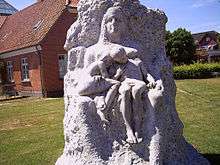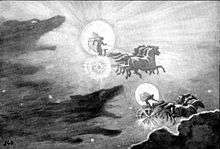Jörð
Jörð (Old Norse jǫrð, "earth") is the personification of earth and a goddess in Norse mythology. She is the mother of the thunder god Thor, and a sexual partner of Odin.[1] Her name is often employed in skaldic poetry and kennings as a poetic term for land or earth.[2]

Name
The Old Norse name jǫrð means 'earth, land' in Old Norse, serving as a noun ('earth') and as a theonymic incarnation of the noun ('Earth-goddess'). It stems from Proto-Germanic *erþō- ('earth, soil, land'), as evidenced by the Gothic airþa, Old English eorþ, Old Saxon ertha, Old High German (OHG) erda, or Faroese jørð.[3][4][5] The Ancient Greek word éra (ἔρα; 'earth') is also possibly related.[3][5] The word is most likely cognate with Proto-Germanic *erwa/ōn- ('sand, soil'; compare with Old Norse jǫrfi 'sand, gravel', OHG ero 'earth').[4][5]
Fjörgyn is considered by scholars to be another name for Jörð. She is similarly described as Thor's mother and her name is also used as a poetic synonym for 'land' or 'the earth' in skaldic poems.[6][7] The name Hlóðyn, mentioned in Völuspá (50) (as "son of Hlódyn" for Thor), is most likely also used as a synonym for Jörð.[8] The etymology of Hlóðyn remains unclear, although it is often thought to be related to the goddess Hludana, to whom Roman votive tablets have been found on the Lower Rhine.[9][10]
Attestations
Prose Edda
Jörð is attested in the Prose Edda books Gylfaginning and Skáldskaparmál. According to section 10 of Gylfaginning:
- The earth was [Odin's] daughter and his wife. Out of her he begot the first of his sons, that is Asa-Thor.[11]
Additionally, the section describes Jörð's ancestry as follows (the included note is Faulkes's own, and note that Faulkes uses the anglicization Iord throughout his edition of the Prose Edda):
- Narfi or Narfi was the name of a giant who lived in Giantland. He had a daughter called Night. She was black and dark in accordance with her ancestry. She was married to a person called Naglfari. There son was called Aud. Next she was married to someone called Annar. Their daughter was called Iord [Earth].[12]
This section, however, varies by manuscript (see discussion below).
Section 25 of Gylfaginning lists Jörð among the ásynjur (Old Norse 'goddesses', singular ásynja):
- Thor's mother Iord and Vali's mother Rind are reckoned among the Asyniur.[13]
Skáldskaparmál mentions Jörð numerous times, including in several quotes from skaldic poetry. The second section 4 of the book list kennings for the god Thor, including "son of Odin and Iord".[14] Section 17 quotes Þjóðólfr of Hvinir's composition Haustlöng, in which the skald refers to Thor as "the son of Iord" twice. The poem is quoted again in section 23.[15] Section 18 quotes Eilífr Goðrúnarson's composition Þórsdrápa, in which the skald refers to Thor as "Iord's son".[16]
Section 19 contains a list of kennings for the goddess Frigg, including "rival of Iord and Rind and Gunnlod and Gerd".[17] Section 90 contains a list of kennings for Jörð, referencing a variety of skaldic kennings for the goddess:
- How shall earth be referred to? By calling it Ymir's flesh and mother of Thor, daughter of Onar, bride of Odin, rival of Frigg and Rind and Gunnlod, mother-in-law of Sif, floor and base of winds' hall, sea of the animals, daughter of Night, sister of Aud and Day.[18]
The section contains quotes from poems by Hallfreðr vandræðaskáld and Þjóðólfr of Hvinir.[19] The Nafnaþulur section of Skáldskaparmál includes Jörð in a list of ásynjur names.[20]
Additionally, as the common noun jörð also simply means 'earth', references to earth occur throughout the Prose Edda.[21]
Scholarly reception
According to philologist Rudolf Simek, Jörð is "[a]n Æsir goddess, even though she is also called a giantess". Simek highlights parallels between Thor and the Vedic deity Indra: "Just as Thor's counterpart in Indian mythology, Indra, is begotten by the god of the heavens Dyaus and the Earth, so Thor is also the sun of the Earth, just like the proto-ancestor Tuisto ... ".[26]
According to folklorist John Lindow, "Jörd must have been a giantess in the beginning. If so, Odin’s marriage (or, more likely, sexual relationship outside marriage, perhaps not even a willing one on her part) to Jörd should be regarded as parallel to his other strategically minded relationships with giantesses."[1]
Philologist Haukur Thorgeirsson points out that the four manuscripts of Gylfaginning vary in their descriptions of the family relations between Nótt, Jörð, Dagr, and Dellingr. In other words, depending on the manuscript, either Jörð or Nótt is the mother of Dagr and partner of Dellingr. Haukur details that "the oldest manuscript, U, offers a version where Jǫrð is the wife of Dellingr and the mother of Dagr while the other manuscripts, R, W and T, cast Nótt in the role of Dellingr's wife and Dagr's mother", and argues that "the version in U came about accidentally when the writer of U or its antecedent shortened a text similar to that in RWT. The results of this accident made their way into the Icelandic poetic tradition".[27] although its disputed amongst researchers jord is also believed to be odin's first wife but their love died out but they swor to remain good friends but it ended well after all she gave him his favorite son thor. its also said she made the giants who bring the seasons summer spring winter fall and the giant who bring dreams and fair weather and that her son swore to protect them from harm swearing on his hammer and his very life.
Notes
- Lindow 2002, p. 205.
- Orchard 1997, p. 98.
- de Vries 1962, p. 295.
- Orel 2003, p. 86.
- Kroonen 2013, p. 118.
- Simek 1996, p. 86.
- Lindow 2002, p. 117.
- Lindow 2002, p. 206.
- de Vries 1962, p. 239: "... aber die deutung bleibt ungewiss."
- Dronke 1997, p. 150.
- Faulkes (1995: 13).
- Faulkes (1995:13-14).
- Faulkes (1995: 31).
- Faulkes (1995: 72).
- Faulkes (1995: 80-81, 89).
- Faulkes (1995: 85).
- Faulkes (1995: 86).
- Faulkes (1995: 90).
- Faulkes (1995: 90-91).
- Faulkes (1995: 157).
- Faulkes highlights these occurrences in the index of his translation of the Prose Edda; cf. Faulkes 1995: 244.
- Lokasenna 58.
- In Hárbarðsljóð 9, Thor calls himself son of Odin and brother of Meili, who therefore may also be Jörð's son.
- Völuspá 53 (56).
- Dronke 1997, p. 22.
- Simek (2007: 179).
- Haukur (2008:159—168).
References
- de Vries, Jan (1962). Altnordisches Etymologisches Worterbuch (1977 ed.). Brill. ISBN 978-90-04-05436-3.
- Dronke, Ursula (1997). The Poetic Edda II: Mythological Poems. Clarendon Press. ISBN 978-0198111818.
- Faulkes, Anthony. Trans. 1995 [1989]. Edda. Everyman. ISBN 0-460-87616-3
- Haukur Thorgeirsson (2008). "Hinn fagri foldar son" as published in Gripla XIX, pages 159–168. Árni Magnússon Institute for Icelandic Studies.
- Kroonen, Guus (2013). Etymological Dictionary of Proto-Germanic. Brill. ISBN 9789004183407.CS1 maint: ref=harv (link)
- Lindow, John (2002). Norse Mythology: A Guide to Gods, Heroes, Rituals, and Beliefs. Oxford University Press. ISBN 978-0-19-983969-8.
- Orchard, Andy (1997). Dictionary of Norse Myth and Legend. Cassell. ISBN 978-0-304-34520-5.CS1 maint: ref=harv (link)
- Orel, Vladimir E. (2003). A Handbook of Germanic Etymology. Brill. ISBN 978-90-04-12875-0.
- Simek, Rudolf (1996). Dictionary of Northern Mythology. D.S. Brewer. ISBN 978-0-85991-513-7.
